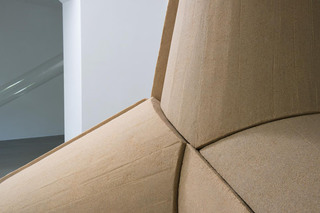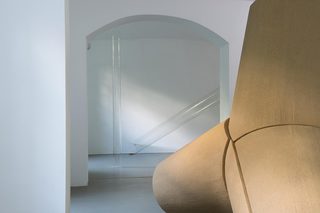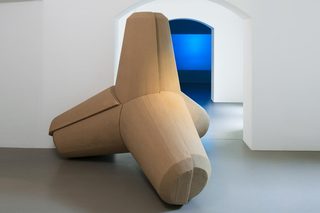Haubitz+Zoche
Tetrapode
<a href="http://www.haubitz-zoche.de/installation">← back to Installation</a>



enter text here
Tetrapode
Sand, Epoxidharz, Styropor, 2,20 x 2,20 x 2,20 m; SZ, 2015
ERES Stiftung München; Musée les Abattoirs FRAC Midi - Pyrénées; Kunstverein Rosenheim; Kunsthaus Nürnberg; Pinakothek der Moderne, München
Vierbeinige Wellenbrecher aus Beton liegen weltweit an Stränden und Häfen, um Küsten vor Erosion zu schützen. Ihre Verwendung ist heute jedoch umstritten, da die natürliche Bewegung des Sandes durch küstennahe Strömungen unterbunden wird und damit ökologische Kreisläufe unterbrochen werden, die für die Meeresflora und -fauna von elementarer Bedeutung sind. Es ist ein deutliches Beispiel dafür, dass beim Eingreifen des Menschen in natürliche Kreisläufe deren Komplexität oft erst Jahrzehnte später sichtbar wird.
Ein Beton-Tetrapode von 2,20 m Höhe wiegt sechs Tonnen. Dies entspricht dem jährlichen pro-Kopf Verbrauch an Sand in Deutschland. Durch die Positionierung dieser wuchtigen Form im Eingangsbereich der Ausstellung macht die Künstlerin diese Menge an Sand physisch erfahrbar.
enter text here
Tetrapode
sand, epoxy resin, styrofoam, 2.48 x 2.48 x 2,48 y; SZ, 2015
ERES Stiftung München; Musée les Abattoirs FRAC Midi - Pyrénées; Kunstverein Rosenheim; Kunsthaus Nürnberg; Pinakothek der Moderne, München
All over the world, four-legged concrete wave-breakers lie on beaches and in harbors to protect coasts from erosion. Today, however, their use is disputed since the sand they should be protecting is often subjected to even greater loss, and the natural movement of the sand through coastal currents is hindered, thus interrupting ecological cycles which are of elementary importance for marine flora and fauna. This is a clear-cut example of how human intervention in natural cycles often renders their complexity visible only decades later.
A concrete tetrapod, 2.2 m high, weighs six tons. This corresponds to the annual per capita consumption of sand in Germany. By positioning this massive form in the exhibition’s entrance area, the artist makes this amount of sand physically palpable.
enter text here
next project
JavaScript is turned off.
Please enable JavaScript to view this site properly.